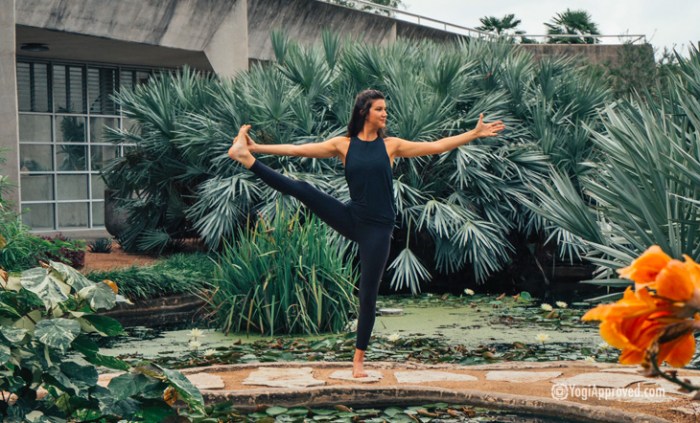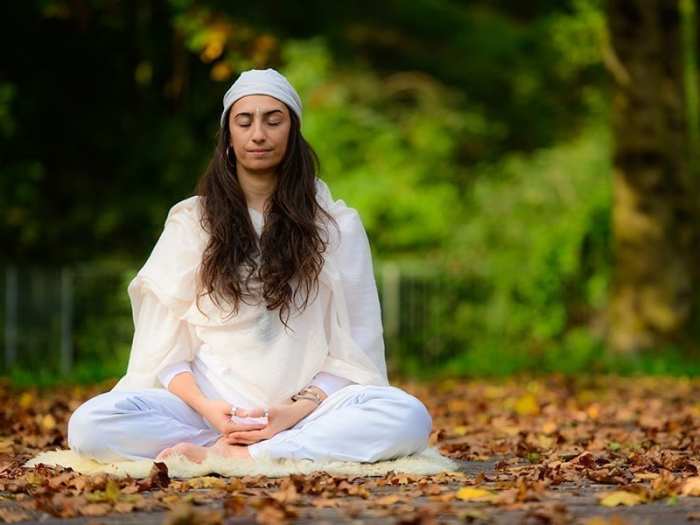Yoga for Spiritual Growth: Cultivating Inner Peace and Self-Awareness

Yoga for spiritual growth is a journey of self-discovery and transformation, a practice that harmonizes the mind, body, and spirit. This ancient tradition, rooted in the philosophy of interconnectedness, offers a path to inner peace, self-awareness, and a deeper understanding of one’s true nature.
Through a combination of physical postures (asanas), breath control (pranayama), and meditation, yoga encourages individuals to explore their inner landscape, cultivate mindfulness, and connect with a higher sense of purpose. It is a holistic practice that transcends the physical realm, inviting practitioners to delve into the depths of their being and cultivate a sense of unity with the universe.
Introduction to Yoga and Spiritual Growth
Yoga, an ancient Indian practice, goes beyond physical postures and breathing exercises. It offers a profound path to spiritual growth, fostering a deeper understanding of oneself and the world.
The Connection Between Yoga and Spiritual Growth
Yoga’s core principles emphasize a holistic approach to well-being, encompassing physical, mental, and spiritual dimensions. This interconnectedness is crucial for spiritual growth. By cultivating self-awareness through yoga practices, individuals can transcend the limitations of the physical body and delve into the depths of their inner being.
Examples of Yoga Practices Fostering Self-Awareness and Inner Peace
- Asana (Postures): Yoga postures, when practiced mindfully, promote physical flexibility and balance, leading to a greater sense of control over the body. This physical awareness translates into mental clarity and a heightened sense of self-presence.
- Pranayama (Breathing Techniques): Controlled breathing techniques calm the nervous system, reducing stress and anxiety. This calming effect allows individuals to access a deeper level of consciousness, fostering inner peace and tranquility.
- Meditation: Yoga emphasizes the importance of meditation, which involves focusing the mind on a single point, such as the breath or a mantra. This practice helps to quiet the incessant chatter of the mind, allowing individuals to connect with their true nature and experience a state of profound peace.
The Philosophy Behind Yoga and Its Emphasis on Mind-Body Connection
Yoga philosophy, rooted in ancient Indian scriptures like the Yoga Sutras of Patanjali, highlights the interconnectedness of the mind, body, and spirit. It emphasizes that the physical body is a vessel for the soul and that by nurturing the body through yoga practices, individuals can access a higher state of consciousness.
“Yoga is the journey of the self, through the self, to the self.”B.K.S. Iyengar
Yoga’s emphasis on the mind-body connection is reflected in its practices. Asanas (postures) not only strengthen the physical body but also influence the mind and emotions. Similarly, pranayama (breathing techniques) affect the mind and body, promoting relaxation and clarity. Through this interconnected approach, yoga fosters a harmonious relationship between the physical and spiritual aspects of the individual, paving the way for spiritual growth.
Types of Yoga for Spiritual Development
Yoga, a multifaceted practice encompassing physical postures, breathing techniques, and meditation, offers a profound path to spiritual growth. Different styles of yoga, each with its unique emphasis, can help individuals connect with their inner selves, cultivate awareness, and transcend limitations.
Hatha Yoga
Hatha yoga, the foundation for many modern styles, focuses on physical postures (asanas) and breathing exercises (pranayama). It aims to harmonize the body and mind, preparing the practitioner for deeper spiritual exploration. Hatha yoga emphasizes alignment and stability in poses, promoting a sense of grounding and stability.
“Hatha yoga is the practice of bringing the physical body into harmony with the mind and spirit.”B.K.S. Iyengar
Vinyasa Yoga
Vinyasa yoga, characterized by flowing sequences of poses synchronized with breath, is a dynamic and energetic practice. It emphasizes movement and fluidity, encouraging the practitioner to connect with the present moment and cultivate a sense of inner flow. The continuous movement and breathwork in Vinyasa yoga can promote physical strength, flexibility, and mental clarity.
“Vinyasa yoga is a practice that invites you to surrender to the flow of your breath and body.”
Baron Baptiste
Kundalini Yoga
Kundalini yoga, a powerful and transformative practice, aims to awaken the kundalini energy, a dormant spiritual force residing at the base of the spine. This style utilizes specific postures, breathwork, and chanting to stimulate this energy, leading to increased awareness, emotional release, and spiritual awakening.
Kundalini yoga can be intense and transformative, often involving a combination of physical postures, breathwork, and meditation.
“Kundalini yoga is a practice that can help you unlock your full potential and connect with your true self.”
Yogi Bhajan
Yoga Practices for Cultivating Mindfulness

Mindfulness, the ability to be fully present in the current moment without judgment, is a cornerstone of spiritual growth. Yoga, with its emphasis on body awareness and breath control, offers powerful tools for cultivating mindfulness.
Meditation and Pranayama for Enhanced Mindfulness
Meditation, a core practice in yoga, involves focusing the mind on a single point, such as the breath or a mantra. This practice trains the mind to quiet down the incessant chatter of thoughts, allowing for a state of deep awareness.
Pranayama, the yogic science of breath control, complements meditation by regulating the flow of prana (life force energy). By consciously controlling our breath, we become more aware of our physical sensations and emotional states, fostering a heightened sense of presence.
Incorporating Mindfulness Techniques into Daily Yoga Routine
A mindful yoga practice involves bringing awareness to every aspect of the practice, from the physical postures (asanas) to the breath and the subtle sensations within the body.
Step-by-Step Guide for Mindful Yoga Practice
- Find a Quiet Space: Choose a calm and serene environment free from distractions. Dim the lights, light a candle, or use aromatherapy to create a peaceful atmosphere.
- Set an Intention: Before starting, take a moment to set an intention for your practice. This could be to cultivate peace, reduce stress, or simply to be present.
- Start with Simple Breathing Exercises: Begin with a few rounds of deep, conscious breaths. Observe the rise and fall of your chest and abdomen and the natural rhythm of your breath.
- Engage in Mindful Asanas: As you move into asanas, pay attention to the sensations in your body. Notice the stretch, the pressure, the alignment, and the flow of your breath. Avoid judging your performance, simply observe and accept what is.
- Bring Awareness to Your Thoughts: During your practice, thoughts will inevitably arise. Acknowledge them without judgment and gently guide your attention back to your breath or the sensations in your body.
- End with a Relaxing Savasana: Conclude your practice with a few minutes of Savasana (corpse pose). Allow your body to fully relax and sink into the present moment. Notice the subtle sensations of your breath and the quietness of your mind.
Tips for Creating a Conducive Environment for Mindful Yoga Practice
- Minimize Distractions: Turn off your phone, television, and any other potential distractions. Create a space where you can fully focus on your practice.
- Use Props: Use props like blankets, bolsters, and blocks to support your body and enhance comfort. This can help you relax and deepen your awareness.
- Set a Regular Time: Establishing a consistent time for your practice can help you develop a routine and make it easier to incorporate mindfulness into your daily life.
- Practice Patience: Mindfulness is a skill that takes time and practice to cultivate. Be patient with yourself and don’t get discouraged if your mind wanders. Simply gently guide your attention back to the present moment.
The Role of Breathwork in Spiritual Growth
Breath control, known as pranayama in yoga, is a fundamental practice that plays a crucial role in spiritual growth. Pranayama is more than just breathing exercises; it’s a conscious and deliberate manipulation of the breath to cultivate inner awareness, regulate emotions, and connect with the divine.
Pranayama Techniques and Their Benefits
These techniques offer a variety of benefits for calming the mind and fostering a deeper connection with the inner self. These techniques involve specific breathing patterns and rhythms that influence the flow of prana, the vital life force, throughout the body.
- Nadi Shodhana (Alternate Nostril Breathing): This technique involves alternating breaths through each nostril, balancing the left and right hemispheres of the brain. It promotes mental clarity, reduces stress, and helps to cultivate a sense of peace.
- Ujjayi Pranayama (Victorious Breath): This technique involves constricting the back of the throat slightly, creating a gentle, rhythmic sound. It calms the nervous system, reduces anxiety, and promotes focus and concentration.
- Kapalabhati Pranayama (Skull Shining Breath): This technique involves forceful exhalations through the nose, followed by passive inhalations. It stimulates the respiratory system, increases energy levels, and helps to purify the mind.
Conscious Breathing and Cultivating Presence
Conscious breathing is a powerful tool for cultivating a sense of presence and inner peace. By paying attention to each breath, we become more aware of the present moment and less caught up in the constant stream of thoughts. This practice helps to quiet the mind, reduce stress, and create a sense of calm and equanimity.
Yoga and Emotional Regulation

Yoga, an ancient practice rooted in India, offers a holistic approach to well-being, encompassing physical postures, breathing techniques, and meditation. Beyond its physical benefits, yoga plays a crucial role in fostering emotional intelligence and enhancing our ability to navigate life’s challenges with greater resilience.
Yoga and Emotional Intelligence
Yoga cultivates emotional intelligence by promoting self-awareness, empathy, and the ability to manage emotions effectively. By engaging in mindful movement and deep breathing, individuals become more attuned to their internal states, recognizing subtle shifts in their emotions. This heightened awareness allows them to observe their feelings without judgment, fostering a sense of self-compassion and understanding.
Yoga Poses for Emotional Balance
Certain yoga poses are particularly effective in promoting emotional balance and resilience. These poses target specific energy centers within the body, known as chakras, which are believed to influence our emotional well-being.
- Child’s Pose (Balasana): This calming pose offers a sense of security and grounding, promoting relaxation and reducing stress. It is particularly helpful in releasing tension in the back and shoulders, which can often manifest as physical symptoms of emotional distress.
- Supported Child’s Pose (Uttanasana): This variation of Child’s Pose involves placing a bolster or pillow under the chest and forehead, deepening the sense of relaxation and allowing for a more profound release of tension.
- Supported Forward Bend (Uttanasana): This pose encourages surrender and release, helping to alleviate anxiety and stress. The gentle pressure on the abdomen stimulates the digestive system, which can be beneficial for those experiencing emotional distress.
- Reclining Butterfly Pose (Supta Baddha Konasana): This restorative pose promotes relaxation and opens the hips, which can help release emotional tension held in the pelvic area.
- Twisting Poses (Parivrtta): Twisting poses help to detoxify the body and release stagnant energy, promoting emotional clarity and reducing feelings of overwhelm. These poses also stimulate the digestive system and improve circulation.
Yoga Techniques for Emotional Regulation
Beyond specific poses, yoga incorporates techniques that directly address emotional regulation.
- Mindfulness Meditation: This practice involves focusing on the present moment without judgment, and observing thoughts and feelings without getting carried away by them. Regular mindfulness meditation helps to cultivate emotional awareness, reduce reactivity, and develop a sense of calm amidst life’s ups and downs.
- Pranayama (Breathing Exercises): Breathing techniques, such as deep belly breathing, alternate nostril breathing (Nadi Shodhana), and calming breath (Ujjayi), help to regulate the nervous system and reduce stress. By consciously controlling the breath, individuals can influence their emotional state, promoting feelings of peace and tranquility.
- Yoga Nidra (Yogic Sleep): This guided relaxation technique involves deep relaxation of the body and mind, promoting a state of profound peace and rejuvenation. Yoga Nidra can help to reduce stress, improve sleep quality, and cultivate emotional balance.
Yoga and the Pursuit of Self-Knowledge
The journey of spiritual growth is intricately linked to the pursuit of self-knowledge. Yoga, with its emphasis on introspection and self-awareness, provides a profound path to unraveling the mysteries of the inner self. By delving into the depths of our being, we gain a deeper understanding of our thoughts, emotions, and motivations, paving the way for personal transformation and spiritual awakening.
Yoga Practices for Self-Awareness
Engaging in specific yoga practices can effectively cultivate self-awareness and facilitate personal exploration. These practices offer a unique lens through which we can observe our inner landscape and gain valuable insights into our true nature.
- Mindfulness Meditation: This practice involves focusing attention on the present moment, and observing thoughts and feelings without judgment. By cultivating mindfulness, we become more attuned to our internal experiences, fostering self-awareness and emotional regulation.
- Introspective Asana: Certain yoga postures, such as seated forward bends or twists, encourage introspection and self-reflection. These poses can promote a sense of stillness and introspection, allowing us to connect with our inner world.
- Yoga Nidra: This guided relaxation technique involves deep relaxation and conscious awareness. By quieting the mind and accessing the subconscious, yoga nidra can reveal hidden patterns and beliefs, promoting self-discovery and personal growth.
- Journaling: Keeping a yoga journal can provide a space for reflection and self-exploration. Writing about our experiences, insights, and challenges during yoga practice can help us gain clarity and understanding of our inner world.
Connecting with the Inner Self
Yoga offers a unique framework for connecting with our inner selves and understanding our true nature. Through the practice of yoga, we can access a deeper level of consciousness, transcending the limitations of our ego and connecting with our essential self.
“Yoga is the journey of the self, through the self, to the self.”
The Yoga Sutras of Patanjali
By embracing the principles of yoga, we can cultivate a profound sense of self-awareness, fostering a deeper understanding of our thoughts, emotions, and motivations. This journey of self-discovery can lead to greater self-acceptance, compassion, and a more fulfilling life.
Yoga and the Concept of Dharma: Yoga For Spiritual Growth

Dharma, a fundamental concept in yoga philosophy, refers to one’s natural duty, purpose, or the principle of righteousness. It is often described as the unique path each individual is destined to follow in life, aligning their actions with their true nature and contributing to the greater good.
Exploring dharma within yoga is a journey of self-discovery and spiritual growth, guiding individuals toward a life of purpose and fulfillment.
Yoga Practices for Discovering Dharma
Yoga practices can serve as a powerful tool for individuals to understand their dharma. By cultivating self-awareness and introspection, yoga allows individuals to connect with their inner values and aspirations, guiding them toward a life aligned with their true purpose.
- Self-Reflection and Meditation: Meditation practices, a cornerstone of yoga, create a space for quiet introspection. By observing thoughts and emotions without judgment, individuals can gain clarity on their values, desires, and what truly matters to them. This introspection can reveal hidden passions, talents, and life paths that align with their unique dharma.
- Asana and Pranayama: The physical postures of yoga (asana) and breathwork techniques (pranayama) can also contribute to the understanding of dharma. Asana practices cultivate body awareness and balance, while pranayama techniques enhance focus and clarity. This combination can help individuals become more present in their daily lives, recognizing their strengths and weaknesses, and guiding them towards actions that align with their values and purpose.
- Yoga Sutras: The Yoga Sutras of Patanjali, a foundational text in yoga philosophy, guide living a life by dharma. These sutras emphasize the importance of self-discipline, ethical conduct, and the pursuit of knowledge. By studying and reflecting on these teachings, individuals can gain insights into their responsibilities and the path toward fulfilling their dharma.
Examples of Dharma in Action
The concept of dharma has inspired individuals across cultures and time to live purposeful lives. Here are some examples of how yoga has helped individuals discover and fulfill their dharma:
- A musician who struggled with self-doubt found solace in yoga and meditation. Through these practices, he gained confidence and clarity, allowing him to pursue his passion for music with renewed enthusiasm and purpose. His music became a source of inspiration and joy for others, fulfilling his dharma as an artist.
- A social worker who felt overwhelmed by the challenges of her profession found guidance in the Yoga Sutras. The teachings on compassion, service, and non-attachment helped her find meaning and purpose in her work. She discovered that her dharma was to serve others and make a positive impact on the world.
- A business leader who felt lost and unfulfilled in his career discovered the importance of balance and mindfulness through yoga. By incorporating yoga practices into his daily routine, he found greater clarity and purpose in his work. He learned to prioritize his well-being, create a healthy work-life balance, and lead with integrity, aligning his actions with his values and fulfilling his dharma as a leader.
The Benefits of Yoga for Spiritual Growth
Yoga, a practice that encompasses physical postures, breathing techniques, and meditation, goes beyond physical well-being. It provides a profound path toward spiritual growth, fostering inner peace, self-awareness, and a deeper connection with the universe. The transformative power of yoga lies in its ability to cultivate qualities like self-compassion, forgiveness, and emotional regulation, leading to a more fulfilling and meaningful life.
The Benefits of Yoga for Spiritual Growth
Yoga offers a holistic approach to spiritual development, encompassing various aspects of human existence. Here’s a table outlining the benefits of yoga practices for spiritual growth:
| Benefit | Description | Yoga Practices | Examples |
|---|---|---|---|
| Self-Compassion | Cultivating self-compassion involves treating yourself with kindness, understanding, and acceptance, even when facing challenges. |
|
|
| Forgiveness | Forgiveness is a process of releasing resentment and anger towards oneself or others, allowing for emotional healing and inner peace. |
|
|
| Inner Peace | Inner peace is a state of mental and emotional tranquility, characterized by a sense of calmness, contentment, and balance. |
|
|
Conclusion
This exploration of yoga and its profound connection to spiritual growth has unveiled a multifaceted path to self-discovery and inner transformation. Yoga, with its ancient wisdom and time-tested practices, offers a holistic approach to well-being, encompassing the physical, mental, and spiritual dimensions of our being.
The Transformative Power of Yoga, Yoga for spiritual growth
The journey of yoga, as we have seen, is not merely about achieving physical flexibility or mastering complex poses. It is a journey of self-exploration, self-acceptance, and ultimately, self-realization. Yoga practices like mindfulness, breathwork, and meditation cultivate a deep sense of awareness, allowing us to connect with our inner selves and the world around us in a more profound way.
Through these practices, we learn to observe our thoughts and emotions without judgment, cultivate inner peace, and release limiting beliefs that hinder our spiritual growth.
Ultimate Conclusion

Embracing the principles of yoga for spiritual growth can lead to profound personal transformation. By integrating yoga practices into daily life, individuals can cultivate emotional resilience, develop a deeper sense of self-compassion, and foster a connection to something greater than themselves.
The journey of spiritual growth through yoga is a lifelong exploration, offering endless possibilities for personal evolution and a deeper understanding of the interconnectedness of all things.
Comments are closed.